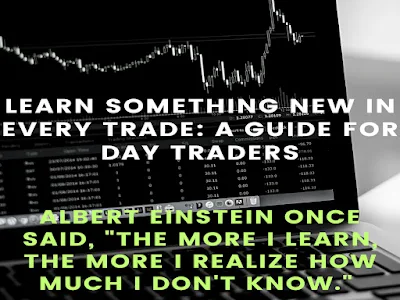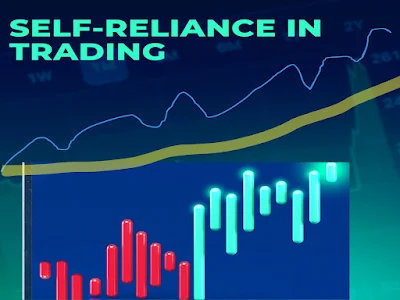Introduction
Have you ever wondered how to follow the process in day trading successfully? It's a world filled with opportunities and risks, where fortunes can be made or lost in the blink of an eye. In this article, we'll take you through a journey of day trading, demystifying the complexities and providing insights into how you can navigate this financial landscape. So, fasten your seatbelts and get ready to dive into the exciting world of day trading.
I. Understanding
Day Trading
What is Day
Trading?
Day trading is a
dynamic strategy where traders buy and sell financial instruments within the
same trading day. It requires a deep understanding of market trends, quick
decision-making, and a willingness to embrace risk.
The Psychology of
Day Trading
Explore the
psychological aspects of day trading, including managing emotions, stress, and
maintaining a disciplined mindset. We'll uncover the mental fortitude required
to succeed in this fast-paced environment.
II. Getting
Started in Day Trading
Setting Up Your
Trading Workspace
Discover the
importance of an efficient workspace. We'll guide you on the necessary tools,
software, and hardware to ensure you're ready to make informed decisions in
real-time.
Selecting the
Right Broker
Choosing the
right brokerage is crucial in day trading. We'll walk you through the
considerations for selecting a reliable and suitable broker to execute your
trades.
Creating a
Trading Plan: Your Roadmap to Success
Creating a
trading plan is akin to mapping out your journey in the world of day trading.
It's not only essential; it's your compass, keeping you on track and helping
you achieve your financial goals while mitigating risks. Here's a detailed breakdown
of what your trading plan should encompass:
1. Define Your
Objectives
Start with the
big picture. What are your financial goals? Are you looking for short-term
profits or long-term investments? Be specific about what you want to achieve,
whether it's a daily income target, retirement savings, or any other financial
milestone.
2. Risk Tolerance
Assessment
Determine how
much risk you're willing to take. Assess your risk tolerance based on your
financial situation, personality, and trading experience. Are you comfortable
with high-risk, high-reward strategies, or do you prefer a more conservative
approach?
3. Asset
Selection
Decide what you
will trade. Will it be stocks, forex, cryptocurrencies, or commodities?
Understanding the market you choose is crucial. Each market has its unique
characteristics and risks.
4. Position
Sizing and Leverage
Determine the size
of your positions and the leverage you'll use. Position sizing ensures that you
don't overcommit your capital in a single trade. Leverage amplifies your
trading power, but it also increases risk.
5. Entry and Exit
Strategies
Define your entry
and exit criteria. What technical or fundamental indicators will trigger a
trade? How will you set stop-loss and take-profit levels to manage risk and
secure profits?
6. Risk
Management
Lay out a
comprehensive risk management strategy. This includes setting a maximum risk
per trade, diversifying your portfolio, and having a clear plan for managing
losses.
7. Trading
Schedule
Establish a
routine. Decide when you'll trade, considering market hours and your
availability. Maintaining consistency in your trading schedule can help you
make better decisions.
8. Contingency
Plans
Prepare for the
unexpected. What will you do if a trade goes against you? Having contingency
plans for various scenarios, such as sudden market volatility, is crucial.
9. Performance
Evaluation
Set benchmarks
for your trading performance. Regularly review your trading plan and assess
whether you're meeting your goals. Make adjustments as necessary.
10. Emotional
Discipline
Acknowledge the
psychological aspect of trading. Develop strategies to manage emotions like
fear and greed, which can cloud judgment.
11. Documentation
Record every
trade. Keeping a trading journal is essential for tracking your progress,
analyzing your strategies, and making data-driven improvements.
12. Continuous
Learning
Commit to ongoing
education. The trading landscape evolves, and continuous learning is key to
staying competitive and adapting to market changes.
Creating a
trading plan may seem like a meticulous task, but it's your safeguard in the
volatile world of day trading. A well-thought-out plan provides structure,
discipline, and a clear path to success. Remember that, as a day trader, you're
not just following a plan; you're following your own roadmap to financial
independence.
III. Mastering
Technical Analysis
Deciphering
Candlestick Charts and Patterns
Dive deep into
the world of candlestick charts and patterns, unraveling their secrets and
understanding their significance in day trading. You'll grasp the art of
reading these charts and identifying patterns that can be powerful tools for
predicting market movements.
Navigating the
Landscape of Indicators and Oscillators
Embark on a
journey through the intricate realm of technical indicators and oscillators.
Gain insights into their interpretation, and discover how to leverage them
effectively to pinpoint entry and exit points in your trading strategy.
IV. Risk
Management and Strategies
Capital
Management
Discover the
importance of managing your capital wisely. We'll discuss risk per trade,
position sizing, and stop-loss strategies that protect your investment.
Trading
Strategies
Explore various
trading strategies, such as scalping, day trading, and swing trading. We'll
help you choose the one that aligns with your goals and risk tolerance.
V. Monitoring and
Review
Real-time
Monitoring
Learn how to
monitor your trades in real-time and adapt to changing market conditions. We'll
provide tips on staying agile and making informed decisions.
Review and
Analysis
After the trading
day ends, it's essential to review your performance. We'll guide you on
evaluating your trades, identifying strengths, and learning from your mistakes.
Conclusion
In the world of
day trading, following the process is the key to success. It requires
dedication, discipline, and a commitment to continuous learning. Now that
you've journeyed through the art of day trading, you may have more questions
than when you began. But remember, every successful day trader started with
curiosity and a thirst for knowledge.
As you embark on
your day trading adventure, keep these words in mind:
"The stock
market is filled with individuals who know the price of everything but the
value of nothing." - Philip Fisher
So, are you ready
to follow the process in day trading? It's an ever-evolving journey, filled
with challenges and triumphs. Start small, build your skills, and remember that
even the most successful traders started at the beginning. Keep learning, stay
curious, and let the world of day trading unveil its secrets to you.
Happy trading!







